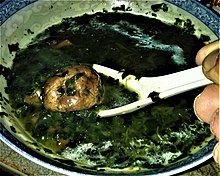Patriotic soup
 Homestyle version of the patriotic soup | |
| Alternative names | Protect the country dish |
|---|---|
| Type | Soup |
| Place of origin | China |
| Region or state | Chaoshan |
| Main ingredients | Edible leaf vegetable (amaranth, spinach, ipomoea aquatica, sweet potato leaves, chard or other leafy greens), Edible mushrooms (volvariella volvacea, shiitake, black wood ear, cloud ear fungus, white wood ear or other fungi), broth (vegetable, beef, chicken, pork, or other stocks), starch, salt, sesame oil |
| Patriotic soup | |||||||||||
|---|---|---|---|---|---|---|---|---|---|---|---|
| Traditional Chinese | 護國菜 | ||||||||||
| Simplified Chinese | 护国菜 | ||||||||||
| Hanyu Pinyin | hùguó cài | ||||||||||
| Literal meaning | Protect the country dish | ||||||||||
| |||||||||||
Patriotic soup (simplified Chinese: 护国菜; traditional Chinese: 護國菜; pinyin: hùguó cài; lit. 'protect the country dish', Teochew :hu gog chai) is a vegetable soup originated by Teochew people. It was developed during the final year of China's Song dynasty as an improvisational dish.
History[]
According to the locals at the Guangdong Province,[1] prior to the Battle of Yamen, Song's last emperor Zhao Bing and his regime's remnants sought shelter in a monastery at Chaozhou. The monastery's monks served an impromptu vegetarian soup made of leaf vegetable, edible mushrooms, and vegetable broth. The emperor loved the soup and named it "protect the country dish" (護國菜).[2] A later generation named it in English "patriotic soup". After Zhao Bing died, the preparation of the soup became a way to honor the last Song emperor.
Preparation[]
The soup became a part of Teochew cuisine, and its recipe evolved over time. Although the Chinese since the Ming dynasty commonly use sweet potato leaves, other varieties include amaranth, spinach, ipomoea aquatica and other leafy greens; and alternative broths such as beef or chicken.[3][4][5] Other ingredients are often added such as beaten eggs,[6] shredded dry cured ham, tofu, cellophane noodles, etc. Guangdong Province's restaurants routinely decorate the soup in a taijitu diagram.[7] However, the most authentic version of the soup typically is homemade and simply prepared just using leaf vegetable, edible mushrooms, and vegetable broth.[8]
See also[]
References[]
- ^ Fang Xiaolan (方曉嵐 ); Chen Jilin (陳紀臨) (2012). Traditional Chaozhou Cuisine (外婆家的潮州菜) (in Chinese). Hong Kong: Wan Li Book Co. Ltd. (萬里機構). pp. 90–91. ISBN 9789621446237.
- ^ "Nanyuan Restaurant - Authentic GD Cuisine". newsgd.com. Retrieved 1 January 2018.
- ^ Chan, Kei-Lum (2016). China: The Cookbook. Phaidon Press Limited. p. 93edition=1. ISBN 9780714872247.
- ^ "护国菜(菠菜羹)". 豆果. Retrieved 4 September 2017.
- ^ 方曉嵐; 陳紀臨. "護國菜". myCOOKey (in Chinese). Retrieved 15 October 2019.
- ^ "护国菜(菠菜羹)". 豆果美食. Retrieved 1 January 2018.
- ^ "潮汕名羹"太极护国菜"". kknews. Retrieved 21 October 2019.
- ^ "生活夜校:饮食也"护国" 原来关佢事……". 东网. 东网. Retrieved 2019-10-21.
- Teochew cuisine
- Vegetable soups
- Chinese soups
- Buddhist cuisine
- Mushroom dishes
